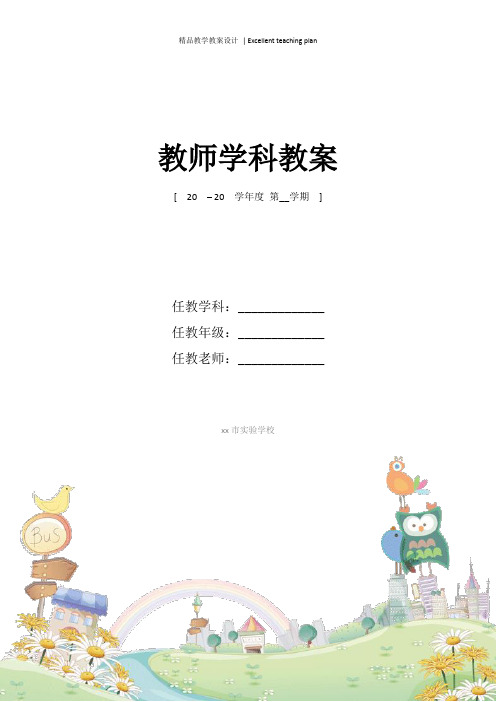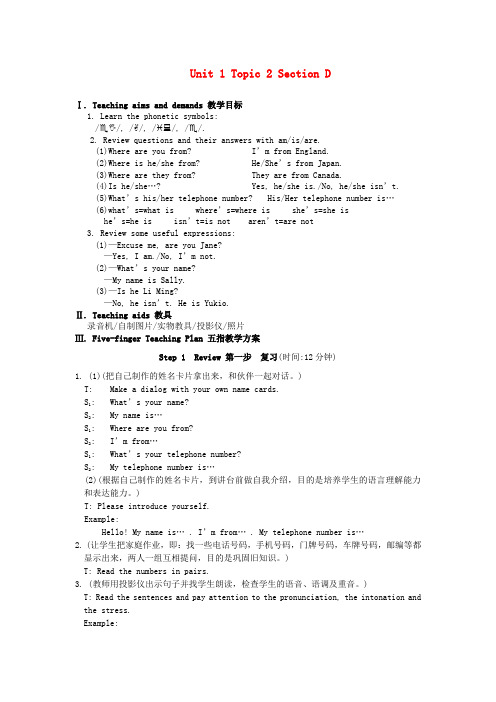【英语教案】Unit1_Topic2_SectionD教案[001]
- 格式:pdf
- 大小:8.76 KB
- 文档页数:4

Unit 1 Topic 2 I’ll kick you the ball again.Section D【教学构思】一、教材分析:本课属于课标话题人与社会——“文娱与体育(Recreation and sports)”中体育与赛事(Sports and matches)项目,主要谈论英格兰最受欢迎的球类运动,即足球和板球。
本课属于课标功能意念表“社会交往(Social communications)”中建议(Suggestions)、请求与提供帮助(Asking for and offering help)和道歉(Apologies)项目和“态度(Attitudes)”中判断与评价(Judgement and evaluation)项目,主要学习英格兰最出名的球类运动,巩固表达建议、请求和道歉等功能的表达法。
主要教学活动为1a和2。
Section D是一节复习课,在综合复习Sections A-C的词汇、语法和功能句的基础上,巩固学生本周的学习内容。
通过阅读写作的拓展练习,延伸学生的学习内容,检测学生综合运用语言的能力。
二、设计说明:根据学情和本课的语法及话题,本节课的教学设计将说、读、写相结合,通过复习本话题所学的词汇、语法和功能句,巩固学习内容。
通过阅读1a了解他国的球类文化,领会篇章结构,获取文章主要信息。
Project活动通过查阅信息写一篇短文介绍自己最喜爱的体育运动,然后分小组讨论该运动的相关知识等,最后在全班作报告,以此巩固本话题所学重要词汇、语法和功能句。
本课在重、难点突破的方法上有所创新,教师运用希沃白板5软件中的游戏竞赛活动,帮助学生复习本话题所学的语法语言知识,既可实现有效复习,又可活跃课堂气氛,调动学生的积极性和主动性。
阅读后完成相关练习并根据思维导图复述课文,提高学生的思维品质和语言能力。
【教学目标】1. 能正确运用本单元所学内容、比较流利地谈论自己最喜欢的体育运动项目的历史、影响、规则及意义,构建语言意识,提升“说”的语言能力。

教师学科教案[ 20 – 20 学年度第__学期]任教学科:_____________任教年级:_____________任教老师:_____________xx市实验学校仁爱英语九年级上册Unit1 Topic2 SectionA---SectionD 教案Section AThe main activities are 1a, 2 and 3a. 本课重点活动是1a, 2和3a。
Ⅰ. Teaching aims and demands 教学目标1. Master some new words and useful expressions:probably, European, population, take place, because of, policy, neither, recent2. Go on studying the present perfect with “just, already, yet, ever, never”:(1) I have just called you.(2) Have you found him yet?(3) Have you ever been to France?(4) I’ve never been there before, …(5) But great changes have already taken place in China recently.3. Talk about the changes of economy and population in China.4. Let the students know that they should cherish the happy life now. Ⅱ. Teaching aids 教具录音机/多媒体课件/两张全家福照片(旧与新)/小黑板/超市购物图Ⅲ. Five-finger Teaching Plan 五指教学方案Step 1 Review 第一步复习(时间:12分钟)(教师出示一张超市购物图,通过询问学生是否曾去购物,引入本课话题。

Step 1 Leading-inT:Do you like sports?S1:Yes, I do.T: What kinds of sports do you like ?S1: I like soccer best.T: How often do you play soccer?S1:Twice a week.T: How do you feel after you do sports for a long time?S1:I often feel tired.T: Why do you play it?S1: Because it can make me strong.Step2 Learn by themselves1.Listen and answer:(1)What did the boy eat one year ago?(2)What does the boy do every morning?2.Read 1a again and finish 1b.3.Read and find:(1)一个十五岁的男孩(2)一年前(3)变累(4)看见某人正在做某事(5)看起来很健康并且充满活力(6)开始跑(7)实行一个1.5米的跑步(8)代替做某事(9)增强某人的体制(10)做某事有乐趣(11)在某方面做得好(12)男子800米比赛4.Explain key points and remember for 5 minutes . Step3 Read and try to retell the passage according to the key words.one year ago -one morning-start-every morning -instead of-build up-feel-become-do well in Step 4 Practice1.Work aloneListen to the dialogue and number the pictures.Review the sentence patterns“Would you mind doing sth.?”and “Could you please do sth.?”2.Sum up the grammer focus of this topic.(1)Would you mind doing sth.?=Could you do sth.? Not at all./Of couse not.(2)Would you mind not doing sth.?=Could you pleasenot do sth.?Sorry, I won’t,/I won’t do it again.(3)will+动词原形won’t+动词原形3.Remember Useful expressions(1)do sb a favor (2)shout at sb(3)be angry with sb. (4)do one’s best(5)say sorry to sb. (6)be sure to do sth.(7)be important to sb./sth. (8)build sb./sth.up(9) have fun doing sth.(10)That’s very kind of you,but I can manage itmyself.(11)Michael,you are always so careless.(12)What do you mean by saying that?(13)-I’m sorry I didn’t call you last night.-Never mind.(14)-I’m sorry for losing your book.-Oh, it doesn’t matter.。


Unit 1 Topic 2 Section DⅠ. Teaching aims and demands 教学目标1. Learn the phonetic symbols:/♏✋/, /✌/, /♓/, /♏/.2. Review questions and their answers with am/is/are.(1)Where are you from? I’m from England.(2)Where is he/she from? He/She’s from Japan.(3)Where are they from? They are from Canada.(4)Is he/she…? Yes, he/she is./No, he/she isn’t.(5)What’s his/her telephone number? His/Her telephone number is…(6)what’s=what is where’s=where is she’s=she ishe’s=he is isn’t=is not aren’t=are not3. Review some useful expressions:(1)—Excuse me, are you Jane?—Yes, I am./No, I’m not.(2)—What’s your name?—My name is Sally.(3)—Is he Li Ming?—No, he isn’t. He is Yukio.Ⅱ. Teaching aids 教具录音机/自制图片/实物教具/投影仪/照片Ⅲ. Five-finger Teaching Plan 五指教学方案Step 1 Review 第一步复习(时间:12分钟)1. (1)(把自己制作的姓名卡片拿出来,和伙伴一起对话。
)T: Make a dialog with your own name cards.S1: What’s your name?S2: My name is…S1: Where are you from?S2: I’m from…S1: What’s your telephone number?S2: My telephone number is…(2)(根据自己制作的姓名卡片,到讲台前做自我介绍,目的是培养学生的语言理解能力和表达能力。

Unit1 Topic2 SectionD 参考教案Ⅰ. Material analysis本节课是一节复习课,主要活动是grammar, functions 及数字的应用。
Grammar部分通过练习的方式引导学生总结主格人称代词的用法。
be动词is, are和疑问代词what/who/where引导的疑问句及缩略形式。
Functions 部分通过引导学生复习Sections A~C,总结本话题所学的询问姓名、电话号码和国籍等功能的表达法。
另外,通过综合练习活动,拓展学生的知识面,巩固数字、询问姓名和国籍等基本情况的表达。
最后,老师通过Project 活动让学生根据要求完成自己的名片设计,培养学生灵活运用所学语言的能力。
Ⅱ. Teaching aims1. Knowledge aims引导学生自主总结be动词am, is, are的一般现在时在不同情况下形式上的变化及缩写形式I’m = I am, they’re = they are, what’s = what is, aren’t = are not, isn’t = is not;引导学生复习用英语表达询问姓名、国籍、电话号码的方式:What’s your name? Where are you from? What’s your telephone number?引导学生总结本话题特殊疑问词what, where, who引导的特殊疑问句及缩写形式。
2. Skill aims能听懂有关询问姓名、国籍、电话号码等基本情况的简单对话或叙述;能运用图文就表示询问姓名、国籍、电话号码等的基本情况的话题进行简单的交流;能正确地朗读对话,并能注意语音语调;能根据已学音标尝试拼读单词;能够初步了解元音字母a, e及辅音字母p, b, t, d, k, g的读音规则。
⒊ Emotional aims能够与同学积极合作,参与课堂活动,大胆实践,培养友好互助的精神;能有兴趣用所学的功能句进行口头对话;使学生乐于接触并了解异国文化。
仁爱版八年级上册Unit 1 Topic 2 Section D教案教学反思教学设计教案仁爱版八年级上Topic2oststudentsliketoeatmeatandhamburgersbest.Somestudentsdon’tlikevegetablesatall._iaoMingandLinTaoliketodrinkcolaverymuch. (让学生讨论1_2分钟,然后找几个学生汇报结果。
)(找一个较胖而平时很少参加体育锻炼的同学进行提问。
)T:S7,eat.T:Doyoulikechipsandchocolate?(板书,教学生词并要求学生掌握chocolate;理解chips。
)chips,chocolateS7:Yes,Ilikethemverymuch.T:Doyouoftendoe_ercise?S7:No,seldom.T:Sodoyouoftengettiredeasily?S7:Yes,Ido.(板书,并要求掌握tired;理解easily。
)tired,easilyT:Boysandgirls,eatingtoomuchmeatmakesusfateasily.Ifefateasilyaso reeveryday?Ss:Yes,orefromnoileT:OK.Noorning,eatfreshfruit,instead,insteadof,build…up,feel T:Accordingtothekeyakeanintervieeetyou!S2:Nicetomeetyou,too!S1:Youlooksoactive.Couldyoupleasetellmeakesyousofitandhealthy? S2:Runningandhealthyeating.S1:berthepictures.2.(做游戏。
练习抱怨与道歉、要求与应答的表达方式。
)(游戏规则如下:把全班同学分成两组(若班级人数多,可先让一半同学参与),排成两列纵队,当教师给出一个提示词组时,第一组的第一个同学要快速说出相应的抱怨或要求的表达方式;随后,第二组的第一个同学快速说出相应的道歉或应答的表达方式;接着,教师给出第二个提示词,这次,由第二组的第二个同学说出相应的抱怨或要求的表达方式,随后,第一组的第二个同学要说出相应的道歉或应答的表达方式。
七年级英语教案Unit1 Topic2 Section D一.Teaching Aims1. Learn some useful words and expressions:excuse me; be from; family; please; telephone; number; zero 2. Learn how to make sentences with special questions: What’s your name? ----My name is……Where are you from? ----I am from……Are you from Canada? ---- Yes I am./No I’m not.二.The key points and difficult pointsLearn how to make sentences with special questions三. Teaching ProceduresStep 1 Lead in (2mins)1. Review some useful sentences:(1)—Excuse me, are you Jane?—Yes, I am./No, I’m not.(2)—What’s your name?—My name is Sally.(3)—What’s your telephone number?—My telephone number/It is 6800-3553.2. Review some personal pronouns:I, we, you, he, she, it, they3. Review the useful short forms:isn’t=is not aren’t=are not she’s=she is he’s=he isthey’re=they are what’s=what is who’s=who is where’s=where is Step 2 Thinking(5mins)Which situation should the letters be capital?1.Show the flashcards with the function sentences on them. Then let students answerit one by one;2.Show his/her hand and count the numbers from 0~10 in English quickly and thenlet students do it in English and imitate the teacher.Step 3 Discussion(5mins)Work in groups, discuss which situation should the letters be capital?Show some examples for capital letters.Step 4 Show time(5mins)1.Choose one student from each group to show the answer.2.Other students or the teacher evaluate the answers.Step 5 Practice(15mins)1.Let students match the subject pronouns with am/is/are.2.In pairs, ask the students to make sentences with special sentences.3.Let students use the key sentences to make short dialogues in pairs. Then choosethree groups to show their dialogues.plete the exercises in page15, ask students to answer the questions. Thencheck the answers.四.Summary(2mins)1.掌握特殊疑问句的用法,能够进行自我介绍及日常对话交流2.掌握一般疑问句的用法,正确使用一般疑问句的回答3.掌握数字的读法,并能制作名片五. Homework1.Make new dialogues with the function sentences;2.Preview the new words in Topic 3 Section A and 1a.。
Unit 1 Topic 2 Section DTeaching aims1.Knowledge aims:掌握本课的重点词汇和短语,复习现在完成时和重点的表达法。
谈论不同的生活环境和生活方式。
2.Skill aims: 培养学生的阅读能力和阅读技巧。
过程和方法:通过文本的自主学习,能够达到训练的要求,提高读的技能3.Emotional aims: (optional) 引导学生了解不同地域的不同生活方式,以及中西方文化和人口差异的密切联系。
. The key points and difficult points1. Key points: Words and phrases: local, capital, huge, market, excellent, surround, garbage, discourage, transportation close to; discourage doing sth.Sentences: I live in a small town called FairmontThe small town is surrounded by trees.2. Difficult points:巩固现在完成时中标志性副词的用法及区别。
能将所学阅读文章中的写作技巧,运用到自己的口语表达和书面表达中。
Learning strategies通过语法和功能部分的复习,能够学会进行归纳和总结。
通过Project的提升,能够将所学知识迁移到自主探究活动中。
通过1的阅读训练,能够学会利用图表归类列举,降低阅读难度。
Teaching aids录音机;幻灯片;不同生活环境的图片等。
教学用时:一课时. Teaching proceduresStage 1 Getting students ready for learning1.Greet and have a competition.Stage2 RevisionRead through the Grammar and Functions and fill in the blanks. Then ask the Ss tosum up the rules of grammar and paying attention to useful expressions.Stage 3 Pre-readingStep 1: Show some pictures of different lifestyles in different countries and lead the Ss to talk about their opinions.(Teacher points to two pictures. One is about the life in the country; the other is about the city life.)T: Now, look at the pictures. Where do you like to live?Ss: I like living in the countryside.Step 2: Present a picture of their town or city to teach the new words.T: Now, look at this picture. This is our school. It is surrounded by the tall buildings. It’s beautiful, but we can also see some garbage somewhere.(Teach other words in the same way)Stage 4 While-readingStep1: Fast-readingGet the Ss to read 1 as quickly as possible and find out where Sue and Li Ming live. T: Now read 1 by yourselves and find out where Sue and Li Ming live. It can help you understand the passage easily.T: OK, where do they live?Step 2: Comprehensive-readingRead 1a and fill in the table.T: Now read 1 again and fill in the table of 1.T: OK, please talk about the advantages of living in a small town.Stage 5 Post-readingStep 1: Read 1 again and get the Ss to underline the words and expressions. Then discuss the key points in groups.Step 2: Guide Ss to discuss where they would like to live based on 1 and tries to list the reasons.Stage 6Write a passage about the living places they like in 2.Blackboard design。
Unit1 Topic2 SectionD教案
教学目标
(一)、知识目标
1、语言知识
1)词汇掌握教材中的四会要求的单词和短语。
2)功能使学生能够询问对方姓名、国籍、电话号码,进行简单的对话交流:A、—What’s your name,please?
—My name is Sally.
B、—Where are you from?
—I’m from Canada.
C、—What’s your telephone number?
—It’s 6807-5335.
3)语法人称代词以及be动词的用法。
(二)、能力目标
1、能听懂有关询问姓名、国籍、电话号码等基本情况的简单对话或叙述;
2、能运用图文就表示询问姓名、国籍、电话号码等的基本情况的话题,进行简单的交流。
(三)、情感目标
1、能体会到英语学习的乐趣。
2、有学好英语的信心,敢于用英语进行表达。
3、能够积极与同学合作参与课堂,大胆实践。
重点难点
教学重点:
1) 使学生掌握询问姓名、国籍、电话号码等的表达方法:
A、—What’s your name,please?
—My name is Sally.
B、—Where are you from?
—I’m from Canada.
C、—What’s your telephone number?
—It’s 6807-5335.
2) 人称代词:I, you,they,we,she,he,it。
3)
be动词am,is,are的一般现在时在不同情况下形式上的变化以及其缩写形式I’m=I am,what’s=whatis,who’s=who is,where’s=where is aren’t=are not,isn’t=is not。
教学难点:
正确使用be动词(am,is,are)及其缩写形式。
学情分析
本节课的授课对象为农村中学七年级学生,刚刚从小学升入初中,学生的
学习兴趣比较浓厚,但是基础参差不齐,有些学生小学阶段学校开设了英语课
有一定的英语基础有些学生小学阶段有学过英语,但是不作为考察科目学了等
于没有学;还有些学生小学阶段根本没有接触过英语的,连26个英文字母都不
懂得。
这一年龄阶段的孩子个性呈现出独立张扬的一面,明显有了独立的思想
,爱展现自我,竞争意识强;因此,教师要帮助学生确立正确的学习态度,教
给他们有效的学习方法和学习策略,养成良好的学习习惯。
课堂教学过程中除
了通过丰富、有趣的活动激发他们学习英语的兴趣外,还应当注意考虑学生的
基础,帮助学生克服学习困难,化难为简,整合教材,使学生获得成功的快乐。
教学过程
Step1 Checking and reviewing
师生问候,听歌曲Where are you from?,通过回答老师问题以及谈论名片内容来复习SectionA、SectionB、Sectio nC的知识。
设计意图:课前热身让学生做好上课的准备,通过听歌曲让学生在轻松地学习
环境中,以最佳的学习状态投入复习课学习中来。
Step2 Showing and presenting
用幻灯片展现Maria的名片,主要的句型,学生口头操练。
—Excuse me,are you Jane?—No,I’m not.
—What’s your name,please?—My name is...
—Where are you from?—I am from…
—What’s your telephone number?—It’s …
设计意图:展示主要句型,唤起学生对本话题主要句型的回忆,为下面自由对
话做好铺垫。
2、老师隐藏所给的主要句型,学生根据名片内容,用自己所掌握的主要句型,
自由进行对话。
3、完成课本P15的Functions。
设计意图:通过对本话题主要功能句型的记忆与运用,达到能根据创设情景进
行交际的目的。
Step3 Consolidation
1、由功能句型中的电话号码,引出数字(0-10)的复习。
设计意图:数字的复习为学生在接下来的说数字比赛做准备做铺垫。
2、两组学生进行说数字比赛,看哪组学生说得又快又好。
3、完成P16的第1题,使数字与图片相匹配。
设计意图:通过说数字比赛,以及数字图片匹配题,使学生进一步巩固对数字
的掌握,为接下来的听力练习做准备。
4、听2录音(一遍),让学生填数字。
5、听2录音(一遍),让学生选择所听到的国家。
设计意图:细节听力训练,使学生能认真捕捉对话细节关键所在。
6、综合以上两遍听力所听的数字和国家名称,完成P16的第2题,核对答案。
设计意图:通过整合听力题目的内容,使其简单化,增强农村学生学英语的信心。
Step4 Practising
1、幻灯片展示书本P15的Grammar—Subject
Pronouns,了解人称主格代词有I,you,he,she,it,we,you,they。
2、核对书本上的语法题(这是预习题,学生已完成)
______ she from Canada?Yes,she is./No,she isn
’t.
______ he LiMing?Yes,he is./No,he isn’t.
______ you from Canada,too?Yes,I am./No,I’m not.
______ they from England? Yes,they are./No,they aren’t.
Who are they? ______ Maria and Jane.
Who’s she/he? ______ is Deng Yaping./
______ is Stephen Hawking
3、认真观察所填be动词和主格人称代词的关系,帮助学生一起总结be动词的口诀。
口诀:我用am,你用are,is连着他她它,单数is,复数are。
设计意图:复习be动词,培养学生通过例句认真观察以及总结的能力。
4、学生完成自我检测的练习,老师拓展be动词的缩写形式。
用am,is,are填空。
(1) .Who______ he?
(2).I______ John Brown.
(3).What ______ your name?
(4).You______ Tom.
(5).Maria and Jane______ from Class 1.
(6).It______ my telephone number.
(7).Her name______ not Kate.
设计意图;巩固be动词的用法,使学生学以致用。
【总结】Summary
1、理解和掌握本单元的生词以及be动词的用法。
2、掌握询问姓名、国籍、电话号码等的表达方法:
A、—What’s your name,please?—My name is Sally.
B、—Where are you from?—I’m from Canada.
C、—What’s your telephone number?—It’s 6807—5335.
【作业】Homework
请介绍一位你的家庭成员,使用句型“What’s her/his name? Where is she/he from? What’s her/his telephone number?”写一段20词左右的介绍他人的短文。